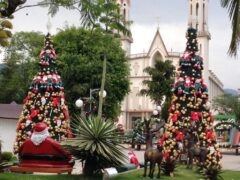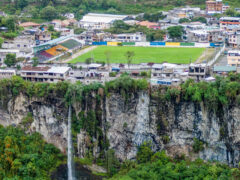Weird Wildlife

Take a look at our list of weird – you’ve probably not even heard of – wildlife in Latin America.
1. CAPYBARA

Native to South America, this cuddly-looking creature looks like it ought to measure just a few inches when, in reality, visitors to the wetland areas where the capybara is common are surprised to find it is the size of a large dog. Perhaps the capybara is confused by this too, as it makes a barking noise when it senses danger. Of course it is in fact a rodent (the world’s largest, no less), but as the species is semi-aquatic it has slightly webbed feet to aid swimming. Somewhat hilariously, the capybara is prone to sunburn: to combat this, it takes advantage of its marshy surroundings to create makeshift sun screen by rolling in mud.
2. GIANT ANTEATER

Normal anteaters look unusual enough, but the giant version truly looks like one of nature’s mistakes. Of course in reality it’s tremendously well-adapted for the one task that is the great passion of every anteater’s life – hoovering up as many tasty ants and termites as possible. The figure can be as many as 30,000 in a single day. This scourge of the insect world is one of the few mammals to have no teeth, instead possessing a 2-foot sticky tongue that it can extend and retract up to 150 times a minute. Soldier ants are the bane of its existence, and it moves quickly from one ant colony to the next to avoid this nemesis, sleeping wherever it finds a quiet corner with its large bushy tail covering its body like a quilt. Amazingly, the giant anteater, which is commonly spotted in the wilderness areas of both South and Central America, can grow to measure up to seven feet in length and weigh ten stone. It can also be aggressive when threatened, fighting its corner on its hind legs. Similarly, the female anteater stands up to give birth, immediately after which the new-born anteater cub will climb onto the mother’s back, where it remains for much of its infancy.
3. HOATZIN

The hoatzin is frequently spotted in the Amazon jungle and the Orinoco Delta in Venezuela, but even more frequently smelled. It is unflatteringly known as the ‘stinkbird’ owing to the fact that its two stomachs cause the bird to pass wind continuously. Luckily, the hoatzin gets the last laugh: its melodiousness has turned the tables on hunters, who flee from the repulsive stench. Further damaging the hoatzin’s popularity, this raucous, flatulent, pheasant-like bird has a call reminiscent of a clapped-out-gearbox. However, there is one group of people who admire the hoatzin, and that’s natural historians. Hoatzin chicks have claws on the thumb and first finger which enable them to climb up trees with great ease, leading scientists to believe that there is a direct link between the bird and the extinct archaeopteryx.
4. MATA MATA TURTLE

A far cry from the more photogenic hawksbill and leatherhead turtles so celebrated by visitors to Latin America, the mata mata is seemingly a throwback to prehistoric times. With its armour of horns and ridged scales, it floats unnoticed in the swamps and marshes of the Amazon and Orinoco Delta until unsuspecting prey swims by… But while this might be one turtle you’d rather not spot while out swimming, it doesn’t pose any threat to humans, preferring a diet of small invertebrates and fish.
5. THREE-TOED SLOTH

The world’s slowest moving mammal is so unhurried that moss grows on its fur – surely a sign if ever there was one that you may have let yourself go a little too much. Doesn’t bother the sloth though: they happily hang upside down all day, sleeping their lives of leisure away, while a slow digestive system and low body temperature ensure that the most they need to achieve in a day is munching on a few leaves. Owing to the sloth’s topsy-turvy lifestyle, its internal organs are in different positions from the norm and its fur grows in the ‘wrong’ direction. In spite all of this, it’s also incredibly cute.
Tailor-made holidays
Flexible, custom-made holidays to Latin America created to match your exact requirements: our tailor-made itineraries are as unique as the clients for whom they are designed.
Design my tripPapagaio
Your edit for Latin American inspiration
Our exciting range of articles on Latin America explore everything from iconic destinations and lesser-known cultural gems to delicious traditional recipes. You’ll also find exclusive travel tips, first-hand client reviews and the chance to get your personal questions answered by our travel experts.
View Extraordinary Inspiration






































